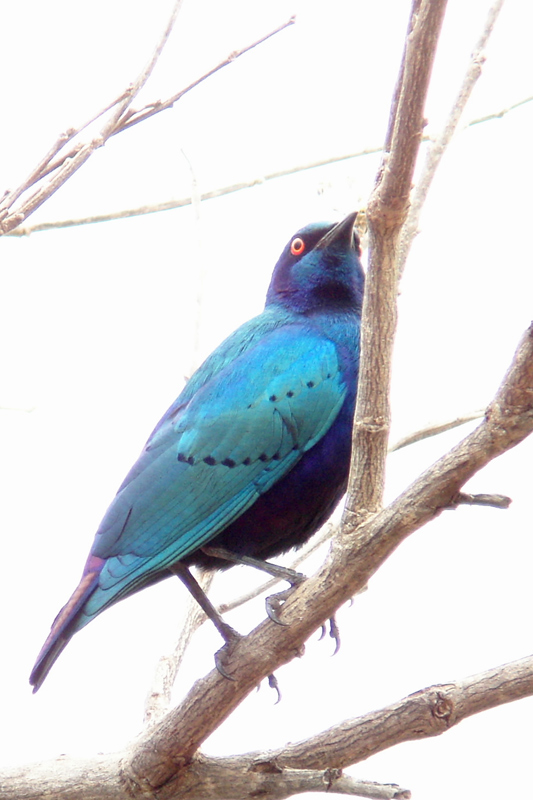Alternative name: Bronze-tailed Glossy Starling
- Lamprotornis chalcurus
Identification
21cm. A rather large, green-looking starling with a short tail.
Often not separable in field from other Glossy Starlings.
- Iridiscent green forehead, crown, nape and mantle
- Black lores, purple ear-coverts
- Blue back and rump with purple tinge
- Blue-green wings with dark blue tips on coverts and tertials
- Purple tail with bronzy gloss and faint barring
- Blue-breen chin, throat, breast, thighs and undertail-coverts
- Purple belly
- Yellow eye
- Black bill and legs
Sexes similar. Juveniles are blackish with a blue ting above and a dark eye.
Distribution
From Senegal and Gambia east to Guinea-Bissau, southern Mali, northern Guinea, northern Ivory Coast and southern Burkina Faso east to Chad, Central African Republic, southwest Sudan, Uganda and western Kenya.
Poorly documented but probably locally common to uncommon in most of its range.
Taxonomy
Clements recognizes 2 subspecies [1]:
- L. c. chalcurus:
- Senegal and Guinea-Bissau to northern Cameroon
- L. c. emini:
- Eastern Cameroon to southwestern Sudan, South Sudan, extreme northeastern Democratic Republic of the Congo, northern Uganda, and extreme western Kenya
Other authorities treat this species as monotypic[2].
Habitat
Open country, open woodland, cultivated areas around villages and towns. Occurs mainly in lowlands, in the east of its range mainly 500 - 2000m, in Kenya above 1000m.
Behaviour
Feeds on insects and fruits.
Forages mainly on the ground, sometimes in trees. Seen in pairs during breeding time, in other times in flocks, also with Greater Blue-eared Starling and Lesser Blue-eared Starling.
Breeding season differs through range. The nest is placed in a tree hole or a stump. Lays up to 4 eggs.
A resident species. Some evidence of seasonal movements.
References
- Clements, J. F., T. S. Schulenberg, M. J. Iliff, D. Roberson, T. A. Fredericks, B. L. Sullivan, and C. L. Wood. 2017. The eBird/Clements checklist of birds of the world: v2017, with updates to August 2017. Downloaded from http://www.birds.cornell.edu/clementschecklist/download/
- Del Hoyo, J, A Elliott, and D Christie, eds. 2009. Handbook of the Birds of the World. Volume 14: Bush-shrikes to Old World Sparrows. Barcelona: Lynx Edicions. ISBN 978-8496553507
- Avibase
Recommended Citation
- BirdForum Opus contributors. (2024) Bronze-tailed Starling. In: BirdForum, the forum for wild birds and birding. Retrieved 18 April 2024 from https://www.birdforum.net/opus/Bronze-tailed_Starling




